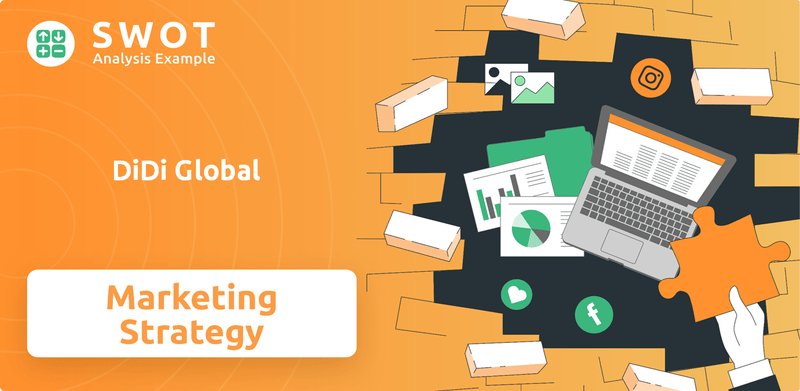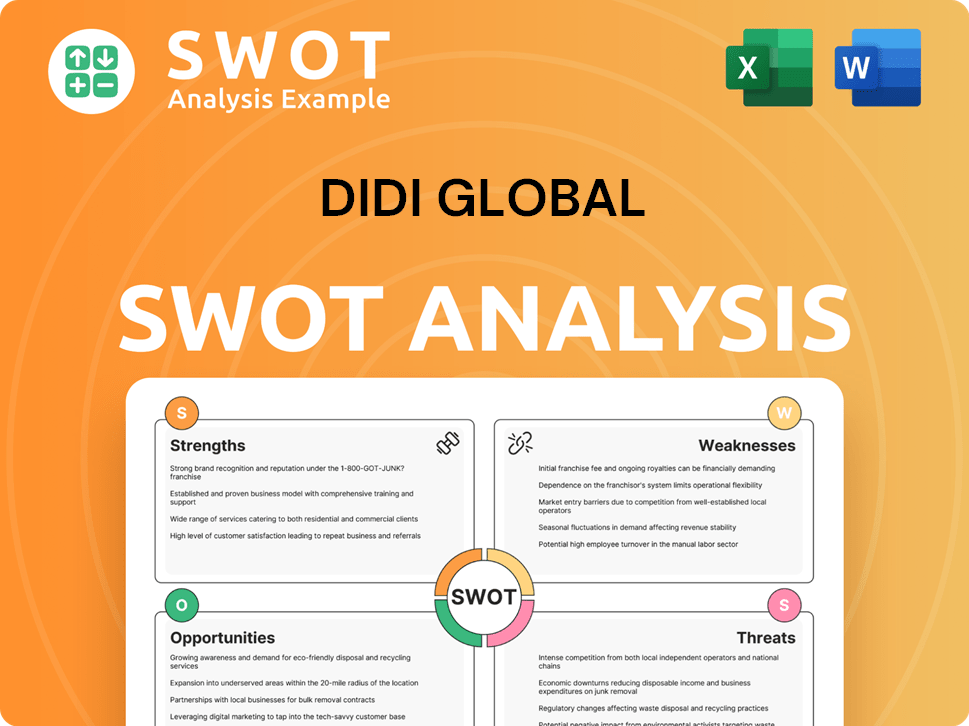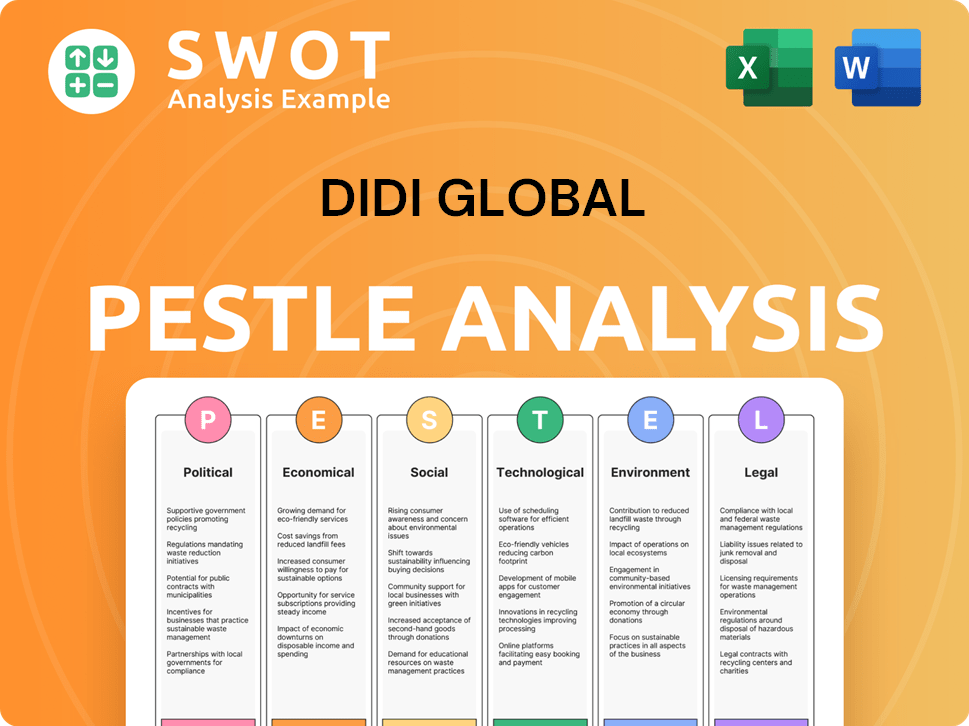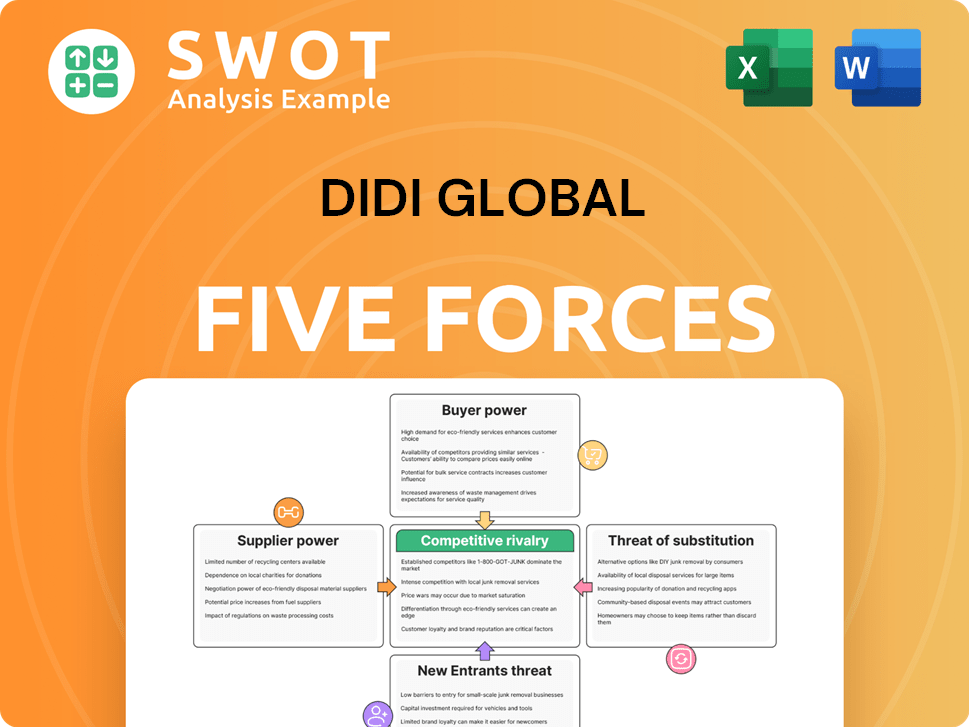DiDi Global Bundle
How is DiDi Global Dominating the Mobility Market?
DiDi Global, a leading mobility technology platform, has masterfully crafted its sales and marketing strategies to become a global powerhouse. From its humble beginnings as a ride-hailing app in China, DiDi has rapidly evolved into a comprehensive mobility and lifestyle platform, serving hundreds of millions of users worldwide. This transformation is a testament to the company's innovative approach to customer acquisition and market expansion.

This deep dive into DiDi Global SWOT Analysis will dissect DiDi's sales strategy and marketing strategy, examining how it navigates the competitive ride-hailing market. We'll explore the company's innovative marketing campaigns, its approach to customer retention, and its strategies for driver acquisition, all crucial elements in understanding DiDi's ongoing success and its ability to compete with other DiDi competitors. Furthermore, we'll analyze DiDi's business model and its expansion strategy in new markets.
How Does DiDi Global Reach Its Customers?
The core of DiDi Global's sales and marketing strategy revolves around its proprietary mobile application. This app serves as the primary sales channel, offering a wide array of services including ride-hailing, food delivery, and financial services. The platform facilitates direct interaction between users and service providers, streamlining operations and enhancing user experience.
DiDi Global's sales strategy also extends to mini-programs within popular platforms like WeChat and Alipay. This approach leverages the massive user bases of these established apps, particularly in the Chinese market, to broaden its reach. These channels provide additional avenues for customer acquisition and service delivery.
The company has strategically expanded its global footprint, with its international business now spanning 14 countries across Latin America, Asia-Pacific, and Africa. This expansion, coupled with service diversification, has been a key driver of growth for DiDi Global.
DiDi Global primarily uses its mobile app for sales, offering ride-hailing, food delivery, and financial services. This direct-to-consumer model allows for efficient service delivery and customer interaction. The app's design focuses on user convenience and ease of access to various services.
DiDi Global forms strategic alliances to expand its market presence and service offerings. Partnerships with companies like Lyft, Ola, Grab, and Bolt help DiDi to extend its reach. Recent partnerships, like the one with Hilton, integrate hospitality and mobility.
DiDi Global utilizes mini-programs on platforms like WeChat and Alipay to boost sales. These programs tap into the large user bases of these popular apps. This approach is particularly effective in markets where these platforms are widely used.
DiDi Global's international expansion strategy focuses on entering new markets and diversifying services. The company's presence in 14 countries demonstrates its commitment to global growth. This strategy has led to significant increases in transaction volume.
DiDi Global's sales strategy is multifaceted, combining direct app sales with strategic partnerships and international expansion. The company's app-centric approach is complemented by its presence on popular platforms and collaborations with other companies. This approach is detailed in Revenue Streams & Business Model of DiDi Global.
- Mobile App: The primary channel for ride-hailing, food delivery, and financial services.
- Mini-Programs: Leveraging WeChat and Alipay for broader market reach.
- Strategic Partnerships: Collaborations with companies like Lyft, Ola, Grab, and Bolt.
- International Expansion: Expanding into new markets and diversifying service offerings.
DiDi Global SWOT Analysis
- Complete SWOT Breakdown
- Fully Customizable
- Editable in Excel & Word
- Professional Formatting
- Investor-Ready Format

What Marketing Tactics Does DiDi Global Use?
The marketing tactics employed by DiDi Global are multifaceted, blending digital and traditional strategies to enhance brand awareness, generate leads, and drive sales. Their approach leverages data analytics for targeted user acquisition and personalized marketing, optimizing the user experience across its app-based services. This data-driven focus is crucial for refining routes, minimizing wait times, and boosting overall customer satisfaction within the ride-hailing and related services.
DiDi's digital marketing strategy includes content marketing, search engine optimization (SEO), paid advertising, and email campaigns. Social media platforms also play a vital role in their engagement efforts. Furthermore, influencer partnerships and localized marketing strategies are key components of their approach, especially in new markets. This comprehensive strategy supports DiDi's goal of expanding its market presence and solidifying its position in the ride-hailing market.
DiDi's marketing efforts also involve traditional media and event participation, such as their presence at MegaCon 2025 in Costa Rica, where it served as the official mobility app. The company is also committed to continuous innovation in autonomous driving and AI applications, which will likely influence future marketing strategies, focusing on the advanced technology integrated into its services. For more insights, you can explore the Target Market of DiDi Global.
DiDi uses content marketing, SEO, paid advertising, and email marketing to reach potential customers. Social media engagement is also a key part of their strategy. These digital tactics help DiDi build brand awareness and drive user acquisition.
DiDi collaborates with influencers to connect with new audiences. A notable example is the ongoing partnership with BRING – Universal Music for Brands. These collaborations often involve live events and targeted campaigns to boost brand visibility.
DiDi tailors its marketing approach for new markets, including targeted advertising, local influencer partnerships, and community engagement. This localized strategy helps DiDi adapt to regional preferences and increase market penetration.
DiDi also uses traditional media and participates in events to increase its reach. Their presence at events like MegaCon 2025 in Costa Rica demonstrates their commitment to offline engagement and brand promotion.
DiDi uses data analytics to personalize marketing campaigns and enhance user experience. This includes optimizing routes, reducing wait times, and tailoring campaigns to specific demographics to improve customer satisfaction.
DiDi plans to invest 10 billion yuan in passenger subsidies in 2025. This investment aims to boost consumption and stabilize driver incomes, supporting both customer acquisition and driver retention strategies.
Sales and marketing expenses increased by 6.8% to RMB 2.6 billion for the first quarter of 2025 from RMB 2.4 billion for the first quarter of 2024. This rise reflects increased marketing expenses and consumer incentives, demonstrating DiDi's investment in its marketing and sales strategies.
- DiDi Pet, launched in over 300 cities in China since November 2024, has nearly 2 million registered pets, showing successful targeted digital outreach.
- The company's continued partnership with BRING – Universal Music for Brands, which will continue in 2025 with more live events, aims to connect with new audiences through music culture.
- DiDi's commitment to autonomous driving and AI applications also points towards future marketing innovations, focusing on highlighting advanced technology in its services.
DiDi Global PESTLE Analysis
- Covers All 6 PESTLE Categories
- No Research Needed – Save Hours of Work
- Built by Experts, Trusted by Consultants
- Instant Download, Ready to Use
- 100% Editable, Fully Customizable

How Is DiDi Global Positioned in the Market?
DiDi Global positions itself as a leading mobility technology platform, aiming to differentiate itself through a comprehensive suite of app-based services and a customer-centric approach. The core message revolves around providing safe, affordable, and convenient mobility solutions, addressing transportation, environmental, and employment challenges through AI and localized smart transportation innovations.
The brand's visual identity and tone are designed to convey reliability and innovation, appealing to a broad target audience seeking efficient and accessible transportation and related services. DiDi emphasizes understanding customer needs by analyzing user behavior data, tailoring services to specific segments, which is a key part of the customer experience.
DiDi's brand consistency is maintained across various channels, from its core app to mini-programs on other platforms. The company adapts to shifts in consumer sentiment and competitive threats, continuously evolving its services. For example, in May 2025, DiDi launched DiDi Comfort in Cairo and Alexandria, offering affordable premium rides, and expanded DiDi Pet to over 300 cities in China by November 2024.
DiDi focuses on understanding customer needs through data analysis to personalize services. This personalization enhances the customer experience and fosters loyalty. The company aims to be a one-stop solution for urban mobility needs, offering a wide array of services.
The company invests in autonomous driving and AI applications to solidify its position as a technology leader. This focus on innovation helps DiDi stay ahead in the competitive ride-hailing market. DiDi's commitment to technological advancements is a key part of its DiDi Global strategy.
DiDi faces competition from global players like Uber and Lyft, as well as regional competitors such as Grab and Ola. Understanding the competitive landscape is crucial for formulating effective DiDi sales strategy and DiDi marketing strategy. For more insights, see the Competitors Landscape of DiDi Global.
Despite a net loss in Q4 2024, DiDi reported a profit attributable to equity holders of RMB 1.3 billion for the full year 2024. This indicates a rebound in financial performance and suggests a resilient brand position. The financial results reflect the effectiveness of DiDi's strategies.
DiDi Global Business Model Canvas
- Complete 9-Block Business Model Canvas
- Effortlessly Communicate Your Business Strategy
- Investor-Ready BMC Format
- 100% Editable and Customizable
- Clear and Structured Layout

What Are DiDi Global’s Most Notable Campaigns?
The sales and marketing strategies of DiDi Global are characterized by significant investment in campaigns, strategic partnerships, and service diversification. These initiatives aim to enhance user engagement, expand market presence, and maintain a competitive edge in the ride-hailing market. DiDi's approach involves a blend of financial incentives, cultural collaborations, and tailored service offerings to meet diverse consumer needs.
One of the key strategies of DiDi is to boost its brand through targeted campaigns. DiDi focuses on customer acquisition and retention through various marketing channels. By analyzing DiDi's marketing campaigns, it's evident that the company is committed to growth and adapting to the evolving demands of the ride-hailing market.
DiDi's sales and marketing approach involves a multifaceted strategy that includes both direct consumer incentives and strategic collaborations. This approach is designed to not only attract new users but also to foster brand loyalty and drive overall business growth. By implementing these strategies, DiDi aims to strengthen its position in the ride-hailing market.
In 2025, DiDi Global allocated approximately 20 billion yuan (around $2.8 billion USD) for various initiatives. This investment includes employment support, consumer promotions, and overseas expansion. The aim is to stabilize employment and stimulate consumption, demonstrating DiDi's commitment to corporate social responsibility while driving business growth.
DiDi has continued its partnership with BRING – Universal Music for Brands, announced in May 2025. This collaboration builds on a successful pop-up event with DJ/Producer Young Franco in late 2024. The goal is to enhance DiDi's 'Cultural Capital' in Australia and connect with new audiences through unique music experiences.
DiDi launched DiDi Comfort in Cairo and Alexandria in May 2025, offering affordable premium rides. The expansion of DiDi Pet, its pet ride service, to over 300 cities in China since November 2024, with nearly 2 million pets registered, indicates a successful campaign targeting a niche market segment.
DiDi's overall performance in Q1 2025 showed that Core Platform Transactions reached 4,247 million, an increase of 13.4% from Q1 2024. This data suggests the effectiveness of its various sales and marketing initiatives. For more details on DiDi's financial performance, check out Owners & Shareholders of DiDi Global.
DiDi Global Porter's Five Forces Analysis
- Covers All 5 Competitive Forces in Detail
- Structured for Consultants, Students, and Founders
- 100% Editable in Microsoft Word & Excel
- Instant Digital Download – Use Immediately
- Compatible with Mac & PC – Fully Unlocked

Related Blogs
- What are Mission Vision & Core Values of DiDi Global Company?
- What is Competitive Landscape of DiDi Global Company?
- What is Growth Strategy and Future Prospects of DiDi Global Company?
- How Does DiDi Global Company Work?
- What is Brief History of DiDi Global Company?
- Who Owns DiDi Global Company?
- What is Customer Demographics and Target Market of DiDi Global Company?
Disclaimer
All information, articles, and product details provided on this website are for general informational and educational purposes only. We do not claim any ownership over, nor do we intend to infringe upon, any trademarks, copyrights, logos, brand names, or other intellectual property mentioned or depicted on this site. Such intellectual property remains the property of its respective owners, and any references here are made solely for identification or informational purposes, without implying any affiliation, endorsement, or partnership.
We make no representations or warranties, express or implied, regarding the accuracy, completeness, or suitability of any content or products presented. Nothing on this website should be construed as legal, tax, investment, financial, medical, or other professional advice. In addition, no part of this site—including articles or product references—constitutes a solicitation, recommendation, endorsement, advertisement, or offer to buy or sell any securities, franchises, or other financial instruments, particularly in jurisdictions where such activity would be unlawful.
All content is of a general nature and may not address the specific circumstances of any individual or entity. It is not a substitute for professional advice or services. Any actions you take based on the information provided here are strictly at your own risk. You accept full responsibility for any decisions or outcomes arising from your use of this website and agree to release us from any liability in connection with your use of, or reliance upon, the content or products found herein.